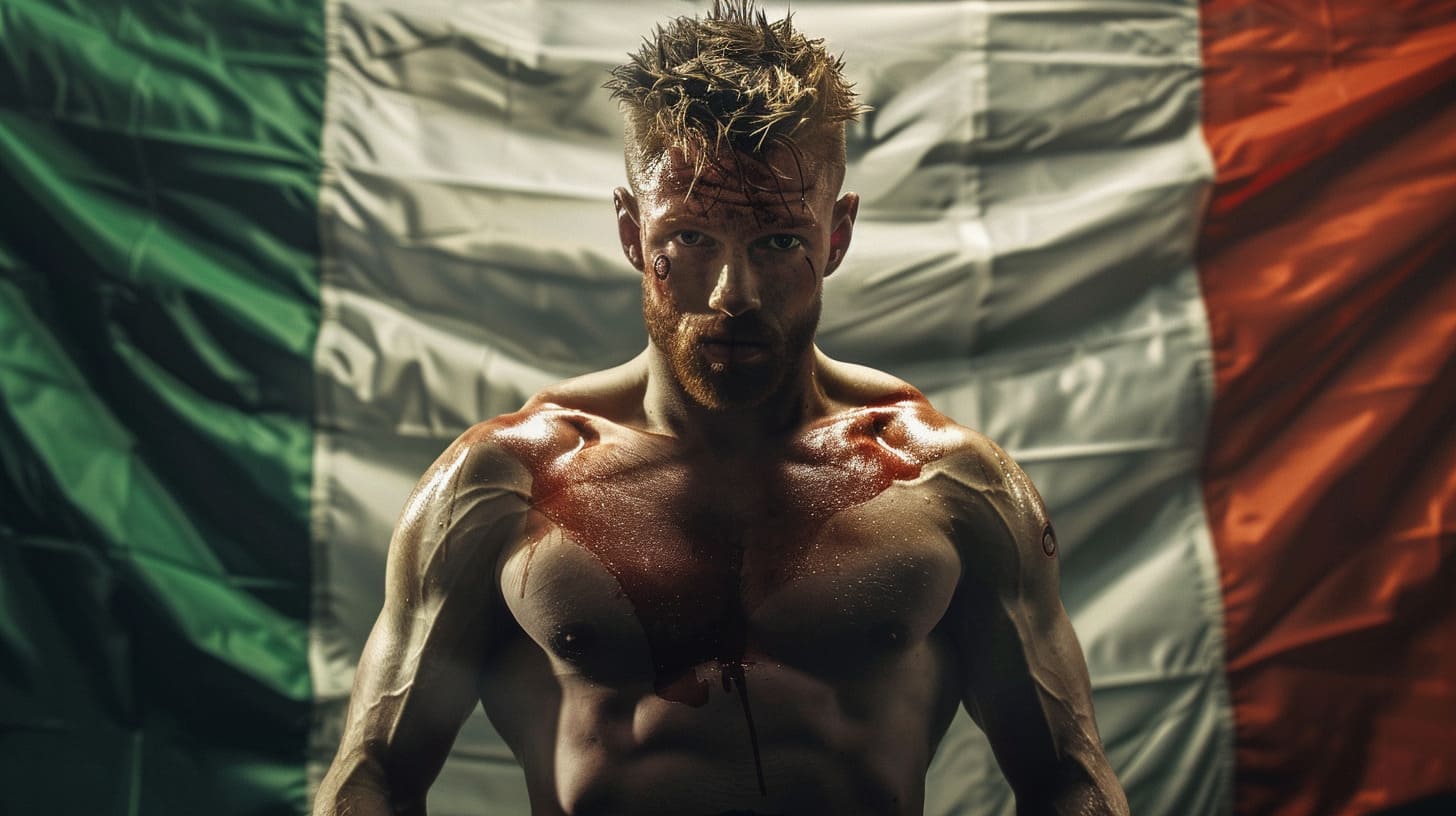The origins of Irish boxing are as complex as they are fascinating, rooted deeply in the country’s struggle and resilience. Though boxing as a formal sport came to Ireland in the 18th century, fisticuffs and bouts were commonplace long before. From challenging times, those who stepped into the informal ring found not only a means of settling disputes but also a source of pride and entertainment.
The Tradition of Bare-Knuckle Boxing in Ireland
- Informal bouts often took place at fairs and gatherings.
- Less about brute force, more about technique and endurance.
- Served as a display of personal and community valor.
Bare-knuckle boxing was not merely a test of strength but an esteemed tradition. Participants honed their skills with a focus on speed, strategy, and technique, knowing well the balance between aggression and restraint.
In this rich fighting history, the Irish Traveller community stands out for its inherent role in fostering and evolving the country’s boxing culture. Often finding themselves on the margins of society, Travellers embraced boxing both as a form of physical expression and a rite of passage.
Transition from Bare-Knuckle to Regulated Boxing
- Introduction of Marquess of Queensberry rules in the late 19th century.
- Shift from endurance-focused bouts to timed rounds and weight classes.
- Emphasis on sportsmanship and fair play.
This transition from informal to formal boxing shaped not only how fights were conducted but also how boxers trained and how audiences engaged with the sport.
Irish Bare-Knuckle Boxing
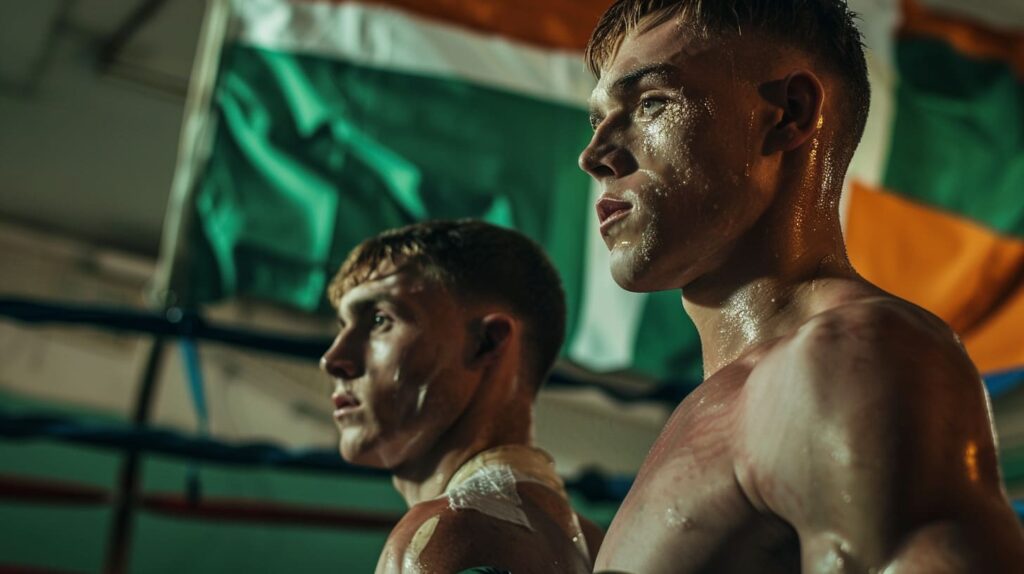
The traditional techniques employed during the bare-knuckle era were as varied as they were effective. Fighters were masters of versatility, often drawing upon a wide range of movements that would catch an opponent off guard.
The Heel of the Hand and Its Strategic Use:
- Aim for facial targets with the palm heel.
- Focus on high-impact, low-injury risk strikes.
- Suited for close combat and control.
The heel of the hand strikes offered a dual advantage, imposing damage with less risk to the knuckles, allowing a fighter to maintain hand integrity throughout the bout.
Sliding Forearm Strikes and Trapped Wrist Strikes:
- Blend punching power with pushing dynamics.
- Use the forearm to block and strike, disrupting an opponent’s balance.
- Trap the opponent’s wrist for a sudden and disarming maneuver.
These methods were clever adaptations, designed not just to harm but to unbalance and outthink the competition.
Collar-and-Elbow
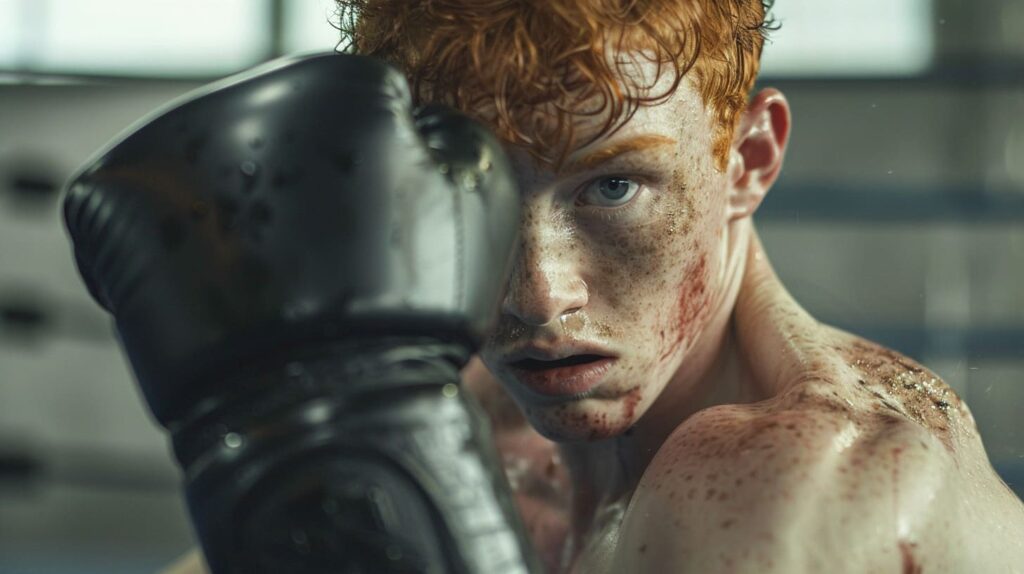
Collar-and-elbow wrestling dates back to rural Ireland, where combatants would clutch each other’s collar and elbow, searching for leverage. Its impact on Irish boxing cannot be overstated, integrating elements of grappling into a striker’s arsenal.
Integration with Boxing Techniques:
- Marked influence on clinching strategies.
- Offered techniques to offset an opponent’s offensive approach.
- Enhanced boxers’ ability to maneuver within close range.
The fusion of wrestling and boxing techniques in the Irish style created a distinctive form of fighter; one who was just as comfortable throwing punches as they were in executing a grappling maneuver.
The Irish Approach
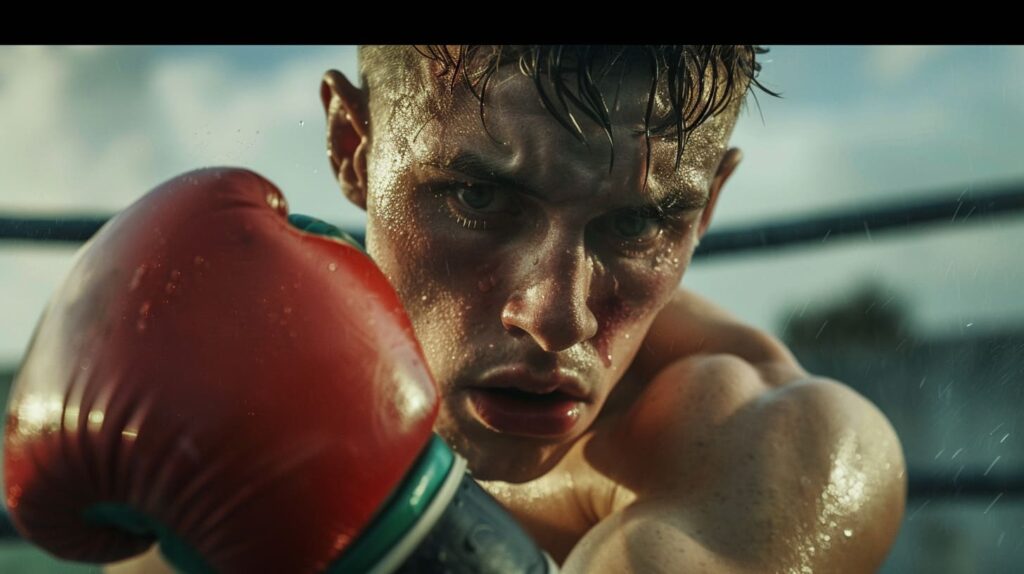
The “Fighting Irish” stance is synonymous with the poise and tactical foresight of Ireland’s boxers. It was crafted through generations, combining a robust defensive position with the readiness to strike effectively.
- Fighting stance is wide and grounded, offering stability and power.
- Hands are held high to protect the face, with elbows in to shield the body.
This well-established position gives fighters a definite advantage, allowing them to respond to an opponent’s moves with agility and force.
Footwork Techniques That Distinguish Irish Boxers:
- Masterful steps and pivots facilitate powerful punches and evasive maneuvers.
- A focus on balance and coordination to exploit openings and control the pace of the fight.
Understanding these movement patterns is crucial. They enable Irish fighters to dictate the tempo of a bout, leading to strategic advantages that often turn the tide in their favor.
Training and Gyms
Behind every great Irish boxer is a gym where the pounding of bags and the chorus of speed ropes underscore a relentless pursuit of excellence. Here’s where raw talent is chiseled into championship material.
How Irish Boxing Gyms Train Fighters:
- Emphasis on technical skills and the repetition of crucial movements.
- Sparring sessions that mimic real-fight scenarios to hone reflexes and strategies.
These gyms are not just physical spaces but sanctuaries where mental fortitude is built, and the spirit of a fighter is forged under the watchful eyes of experienced coaches.
Specific Workout and Conditioning Routines:
- Varied training regimens that focus on strength, speed, and endurance.
- Customized plans addressing the unique style and needs of each boxer.
Beyond technique, Irish boxing gyms place a significant focus on conditioning. After all, a fighter’s arsenal is only as reliable as their ability to deploy it round after round.
Irish Boxing Culture
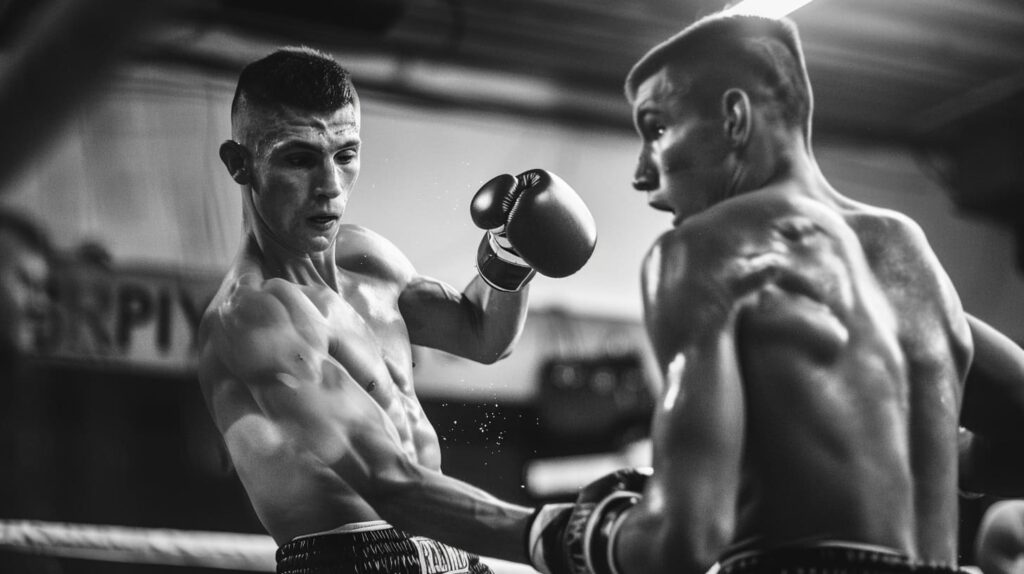
Feel the heartbeat of a tradition where boxing is entwined with the very identity of a nation. It’s a narrative that goes beyond the ring and echoes through the lives of the Irish people.
The Role of Boxing in Irish Society:
- An enduring symbol of struggle and triumph across generations.
- Community events and national pride tightly linked with boxing successes.
Boxing in Ireland isn’t just a popular sport; it’s a cultural cornerstone that narrates stories of personal and collective victories, struggles, and resilience.
Celebrities of the Canvas: Notable Irish Boxers and Champions:
- A pantheon of heroes from Nonpareil Jack Dempsey to Carl Frampton.
- Inspirational tales of those who’ve climbed the ranks to claim world titles.
The legacy of Irish boxers is etched not only in their medals and titles but in the hearts of the people they represent. With every bout, these athletes carry on a lineage of cultural and sporting excellence.
Irish Boxing’s Global Footprint
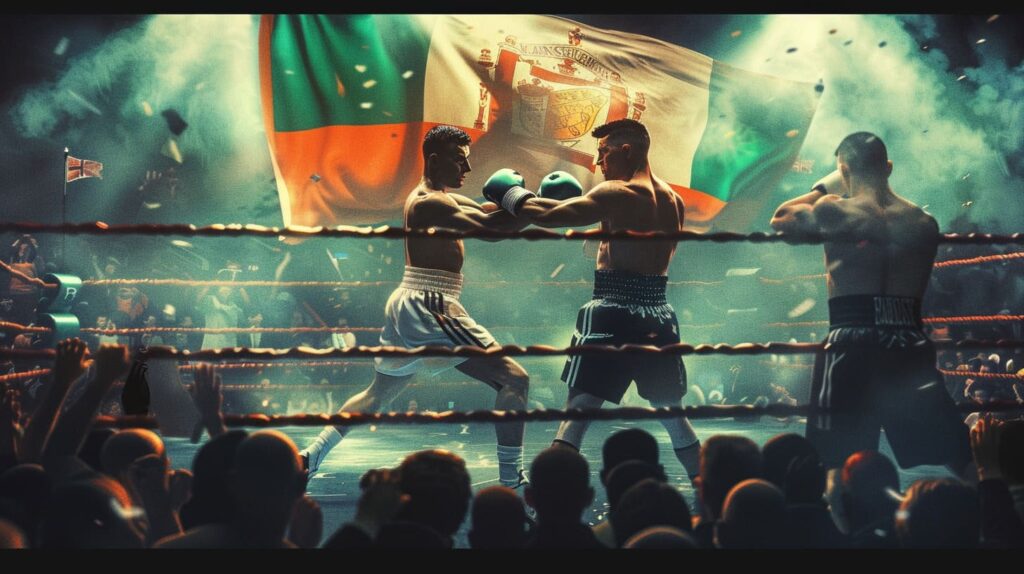
With a pair of gloves and a heart full of determination, Irish boxing has danced its way onto the world stage with undeniable influence. As the sweet science evolved on the Emerald Isle, its disciples carried the torch far and wide, making Irish boxing a celebrated import in places far from its cradle.
From the busy gyms of New York to the sunbathed rings of Australia, Irish boxing techniques and the relentless spirit of its fighters have permeated global boxing culture. Irish-American boxers, in particular, have been pivotal in this cultural exchange, blending the styles taught on the hillsides of Ireland with those developed in the fiercely competitive arenas of the United States.
Impact and Influence Across Borders:
- Irish boxing clubs and fighters found in major cities worldwide.
- Irish fighters frequently headline international boxing events.
The stories of Irish pugilists are told in accents influenced by their new homes, yet their fighting style retains the craft and guile of their ancestors.
Irish-American Boxers’ Contributions to the Sport:
- Historical figures like Jack Dempsey set the stage for future champions.
- Modern fighters bring a touch of Irish flair to the global boxing scene.
The brilliance of Irish boxing traditions lives on, echoed in the strategies and swagger of fighters across the globe, a testament to the enduring legacy of Ireland’s pugilistic prowess.
Rules, Regulations, and Recognition
In the controlled chaos of the ring, rules reign supreme. Irish boxing, with its storied history, is not without its specific regulatory frameworks that ensure fairness and safety for all combatants.
Like the sport itself, the rules of Irish boxing have evolved, with governing bodies establishing clear guidelines for amateur and professional fighters alike. The Boxing Union of Ireland (BUI) and Irish Athletic Boxing Association (IABA) stand as the custodians of the sport’s integrity, steering it with a steady hand.
Framework for Fair Fights:
- Stipulations for amateur and professional bouts.
- Safety measures and equipment requirements.
These regulations provide a canvas on which Irish boxers can paint their bouts with broad strokes of bravery and skill.
Governing Bodies Ensuring Boxing Excellence:
- The BUI and IABA promote and protect the sport’s integrity.
- Collaboration with international bodies for unified rules.
Through constant vigilance and adaptation, the organizations dedicated to Irish boxing uphold a rich tradition whilst keeping pace with modern sporting expectations.
Irish Boxing’s Place in World Combat
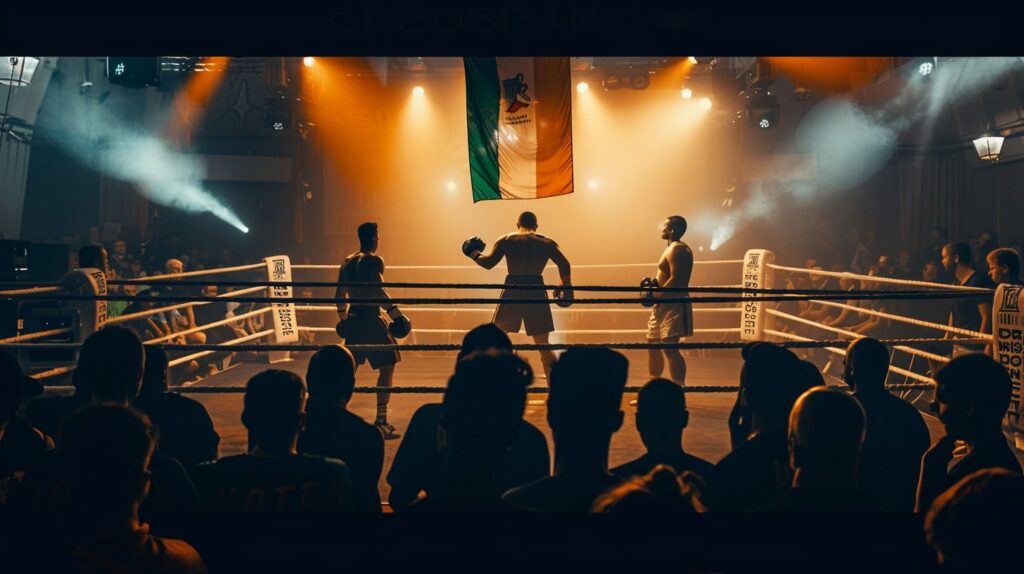
The Irish contribution to the art of boxing stands tall and firm. It’s more than just another style; it carries the weight of history, the flash of skill, and the roar of crowds.
When pitted against other national boxing styles, the Irish approach is defined by its versatility and strategic use of timing and distance. The objective isn’t purely to overpower but to outmaneuver and outthink the opponent, a mind-game played with fists.
Distinct from the Rest:
- Combines traditional techniques with modern strategy.
- Renowned for clever footwork and defensive tactics.
Irish boxers aren’t just participants; they are innovators and artists in the ring, capable of adapting their heritage to meet any challenge.
Strategies for Success:
- Emphasis on pressure fighting with calculated aggression.
- Defensive maneuvers that turn into offensive opportunities.
The canvas of the ring is where Irish boxers articulate a story of combat that draws from deep wells of national identity and personal pride. It’s a story that resonates globally, as Irish boxing continues to earn respect and admiration in the community of world combat sports.
Conclusion
As we reflect on the journey of Irish boxing, from the rural strongholds of bare-knuckle bravery to the bright lights of the world stage, its allure remains magnetic. It’s a style that persists, steeped in tradition, yet perpetually forward-moving, captivating both the ardent aficionado and the casual observer.
This enduring appeal calls out to us to dive deeper and discover more. For in the dance of the Irish fighters, in the resilience of their stance, and in the heart of their legacy lies an untold wealth of stories and lessons—about boxing, about life, and about the undying spirit of a nation.
So whether you’re unboxing gloves for the first time or looking to refine your hook, Irish boxing stands ready to challenge and enchant you. It’s an invitation to step into a world where every punch tells a story, and every fighter builds upon a legacy as timeless as Ireland itself.
